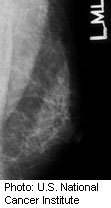
WEDNESDAY, April 21 (HealthDay News) — Having dense breasts has long been known to increase a woman’s risk for breast cancer, and new research confirms that a decline in breast density over time does, in fact, decrease that risk.
New research also has found that women taking hormone replacement therapy are more likely to experience an increase in breast density, a finding consistent with previous research that found women taking the hormones had a 24 percent increased risk for breast cancer.
Both findings were to be presented Tuesday and Wednesday in Washington, D.C., at the annual meeting of the American Association for Cancer Research.
“Over 50 studies have shown that breast density is a strong risk factor for breast cancer,” said Celine M. Vachon, an associate professor of epidemiology in the College of Medicine at the Mayo Clinic, in Minnesota. “Our study is one of the first to examine changes over time,” Vachon said.
A very dense breast has less fat than glandular and connective tissue. Mammogram films of high-density breasts are more difficult to read and interpret than those of less dense breasts.
Vachon and her fellow researchers followed 19,924 women older than 35 who had never had breast cancer and looked at breast density changes and cancer diagnoses over time.
From that group, they randomly picked a sample of 219 women who developed breast cancer during the six-year follow-up period and 1,900 who did not. Women with breast cancer were more likely to have extreme breast density — the highest of four categories — at the start of the study, with 16 percent in the very dense category, compared with 14 percent of those who remained cancer-free.
Those who developed cancer were somewhat less likely than the other women to have a reduction in density of one category or more, with 37 percent of those with breast cancer and 38.6 percent of the other women seeing that change.
Though density generally declines with age, and the breasts become more fatty, “these changes vary from woman to woman,” Vachon said. “And we know the use of postmenopausal hormone therapy can increase density.”
In the other study, researchers from Georgetown University and elsewhere found that the increase in density with hormone use predicted breast cancer risk.
Drawing from the Women’s Health Initiative study, which looked at hormone therapy and other health concerns, they compared 97 women on hormone replacement who developed breast cancer and 77 who did not take hormones but did develop cancer with 733 cancer-free women, some who took hormones and some who did not.
They found that 57 percent of those who did not take hormones had a decrease in density, compared with just 16 percent of those taking hormone therapy.
Breast cancer risk increased nearly fourfold for the 20 percent of women with the biggest increase in density, compared with the 20 percent of women with the lowest increase or a decrease.
When the researchers took the density information out of the analysis, hormone use was not associated with breast cancer risk, they found, leading them to conclude that the change in density accounted for the increased cancer risk.
Dr. Joanne Mortimer, a medical oncologist and director of the women’s cancer programs at the City of Hope Comprehensive Cancer Center in California, said the study results were not surprising.
“We know that breast density probably correlates with the patient’s own estrogen levels,” she said. “The higher the estrogen, the greater the breast cancer risk.”
The new research adds valuable information, she said, about a link that is accepted. Eventually, she said, experts may add density information to established risk models to produce a more precise estimate of an individual woman’s risk.
Another study presented at the meeting found that evaluating breast cancer risk in younger women can be done effectively by using DXA (dual energy X-ray absorptiometry), a lower-radiation option to mammography.
More information
The U.S. National Cancer Institute has more about breast density.

